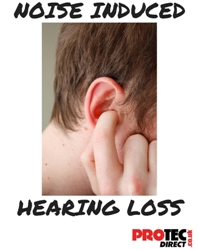If you’ve ever been to see a live band and stood a bit too close to the speakers, you’ll know that when you get home and for the next few hours, your ears ring with a high pitched sound. More than just a reminder that you’ve been out for the evening, this is your ears way of telling you that they’ve sustained some damage and that you need to stand further away or invest in some ear & hearing protection.
In most cases, this ringing will soon stop and the damage done to your ears won’t have any lasting effect. But just imagine if you were exposing your ears to this kind of punishment night after night. It would very quickly get to a point where the damage wouldn’t just go away – with long-lasting and permanent consequences to your hearing being a very real possibility.
And yet, that’s what many of us are exposing ourselves to every day in our working environments. It’s one of the commonest health problems faced at work, with gradual but persistent exposure building up over time into a serious problem. Across all industry, hearing loss accounts for about 75% of civil occupational disease claims.
According to the Health and Safety Executive (HSE) there are a number of industries that are particularly associated with noise induced hearing loss. These include glass bottling lines, wrapping and bagging lines, compressed air machinery, cutting machinery, milling operations and packaging machinery. Of course, this is not an exhaustive list and there are plenty of other jobs that involve excessive exposure to noise.
In order to reduce the danger of noise induced hearing loss, prevention is always the key. Try to control the noise at its source if possible, and while often necessary, wearing protection should be seen as last resort.
Employers need to investigate the noise levels of machinery before purchase, specifically in relation to how close employees need to be. If possible, noisy machines need to be moved into areas where there are no workers – such as a dedicated outbuilding. If that’s not possible, efforts must be made to try and enclose the machinery and reduce the impact of the noise. This can include using anti-vibration mountings. Other preventative measures such as acoustic screens, lining and maintenance can also help to reduce the effects of excessive noise.
It is also a good idea to reduce the duration of exposure by increasing the rotation pattern or providing a noise refuge. Because our ears can quickly become accustomed to the noise, we need to ensure we are doing everything to give them a break and prevent the gradual damage of loud noises.
Of course, if noise is not preventable or still excessive, employers need to provide staff with suitable, good quality and functioning ear protectors. Employees who work in excessive noise environment should also have regular hearing tests from an outside professional to assess their ability and to detect the early signs of hearing damage. All of the above measures are guaranteed and enforced under the Control of Noise at Work Regulations of 2005.
If you are unsure about the noise levels or have any concerns of queries about the damage to your hearing sustained in the workplace, speak to your health and safety representative or consult the HSE website for more information.





Leave a comment